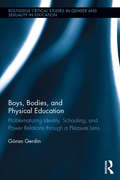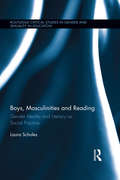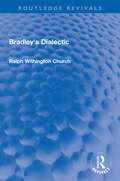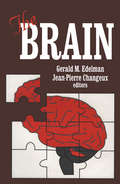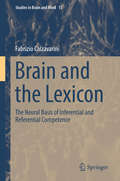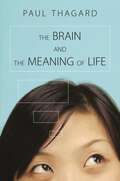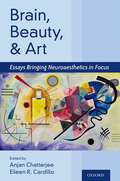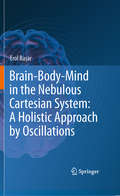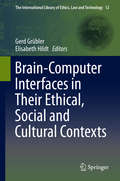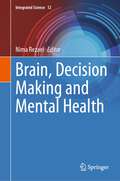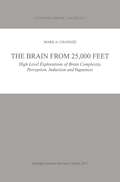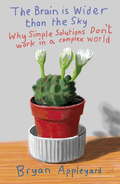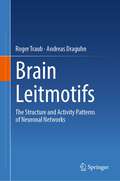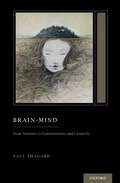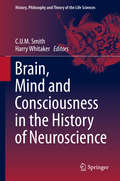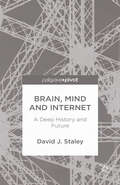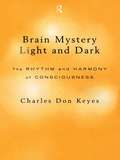- Table View
- List View
Boys, Bodies, and Physical Education: Problematizing Identity, Schooling, and Power Relations through a Pleasure Lens (Routledge Critical Studies in Gender and Sexuality in Education)
by Göran GerdinUsing visual ethnography, this book explores the many forms of pleasures that boys derive in and through the spaces and their bodies in physical education. Employing the works of Michel Foucault and Judith Butler, Gerdin examines how pleasure is connected to identity, schooling, and power relations, and demonstrates how discourses of sport, fitness, health and masculinity work together to produce a variety of pleasurable experiences. At the same time, the book provides a critique of such pleasurable experiences within physical education by illustrating how these pleasures can still, for some boys, quickly turn into displeasures and can be associated with exclusion, humiliation, bullying and homophobia. Boys, Bodies, and Physical Education argues that pleasure can both be seen as an educational and productive practice in physical education but also a constraint that both engenders and privileges some boys over others as well as (re)producing narrow and limited conceptions of masculinity and pleasures for all boys. This book works to problematize these pleasures and their articulations with gender, bodies, and spaces.
Boys, Bodies, and Physical Education: Problematizing Identity, Schooling, and Power Relations through a Pleasure Lens (Routledge Critical Studies in Gender and Sexuality in Education)
by Göran GerdinUsing visual ethnography, this book explores the many forms of pleasures that boys derive in and through the spaces and their bodies in physical education. Employing the works of Michel Foucault and Judith Butler, Gerdin examines how pleasure is connected to identity, schooling, and power relations, and demonstrates how discourses of sport, fitness, health and masculinity work together to produce a variety of pleasurable experiences. At the same time, the book provides a critique of such pleasurable experiences within physical education by illustrating how these pleasures can still, for some boys, quickly turn into displeasures and can be associated with exclusion, humiliation, bullying and homophobia. Boys, Bodies, and Physical Education argues that pleasure can both be seen as an educational and productive practice in physical education but also a constraint that both engenders and privileges some boys over others as well as (re)producing narrow and limited conceptions of masculinity and pleasures for all boys. This book works to problematize these pleasures and their articulations with gender, bodies, and spaces.
Boys, Masculinities and Reading: Gender Identity and Literacy as Social Practice (Routledge Critical Studies in Gender and Sexuality in Education)
by Laura ScholesBoys, Masculinities and Reading explores elementary students’ interpretations of their experiences of reading and the contextual influences that impact those experiences. While research continues to highlight the apparent systematic underperformance of boys in comparison to girls on national and international reading benchmarks, this text moves beyond broad generalizations to consider complexities inherent in notions of masculinity and associated tensions. Applying a socio-cultural perspective, Scholes highlights the voices of boys and girls by focusing on their reading experiences. Examining the perceived, generalized "crisis" of boys’ underperformance in reading and literacy, Scholes identifies the factors that shape perceptions of masculinity among different groups of boys across the globe.
Boys, Masculinities and Reading: Gender Identity and Literacy as Social Practice (Routledge Critical Studies in Gender and Sexuality in Education)
by Laura ScholesBoys, Masculinities and Reading explores elementary students’ interpretations of their experiences of reading and the contextual influences that impact those experiences. While research continues to highlight the apparent systematic underperformance of boys in comparison to girls on national and international reading benchmarks, this text moves beyond broad generalizations to consider complexities inherent in notions of masculinity and associated tensions. Applying a socio-cultural perspective, Scholes highlights the voices of boys and girls by focusing on their reading experiences. Examining the perceived, generalized "crisis" of boys’ underperformance in reading and literacy, Scholes identifies the factors that shape perceptions of masculinity among different groups of boys across the globe.
Bradley's Dialectic (Routledge Revivals)
by Ralph W. ChurchFirst published in 1942, Bradley’s Dialectic is a competent survey of Bradley’s leading philosophical principles, together with its difficulties. The primary objective is to bring out in somewhat simple terms the essential character of Bradley’s dialectic. Here ‘dialectic’ means a method of elucidation. Professor Church’s appraisal of the pertinence of Bradley’s dialectic is heightened by his critical discussion of several less elucidated metaphysical features. In this connection, he submits a penetrating criticism of misrepresentations of Bradley’s views, especially in the important subject of Relations and its place in the structure and development of Thought. Although brief, Professor Church’s analysis is a vital study of crucial themes in philosophy, which will appeal to students of Philosophy and Metaphysics.
Bradley's Dialectic (Routledge Revivals)
by Ralph W. ChurchFirst published in 1942, Bradley’s Dialectic is a competent survey of Bradley’s leading philosophical principles, together with its difficulties. The primary objective is to bring out in somewhat simple terms the essential character of Bradley’s dialectic. Here ‘dialectic’ means a method of elucidation. Professor Church’s appraisal of the pertinence of Bradley’s dialectic is heightened by his critical discussion of several less elucidated metaphysical features. In this connection, he submits a penetrating criticism of misrepresentations of Bradley’s views, especially in the important subject of Relations and its place in the structure and development of Thought. Although brief, Professor Church’s analysis is a vital study of crucial themes in philosophy, which will appeal to students of Philosophy and Metaphysics.
The Brain: Cortical Organization And The Group-selective Theory Of Higher Brain Function
by Jean-Pierre Changeux Gerald M. EdelmanOne of the vastly exciting areas in modern science involves the study of the brain. Recent research focuses not only on how the brain works but how it is related to what we normally call the mind, and throws new light on human behavior. Progress has been made in researching all that relates to interior man, why he thinks and feels as he does, what values he chooses to adopt, and what practices to scorn. All of these attributes make us human and help to explain art, philosophy, and religions. Motion, sight, and memory, as well as emotions and the sentiments common to humans, are all given new meaning by what we have learned about the brain. In an introductory essay, Vernon B. Mountcastle traces the progress made in brain science during this century. Gerald M. Edelman touches upon features of the brain that challenge the picture of the brain as a machine. Semir Zeki discusses artists and artistic expression as an extension of the function of the brain. Richard S. J. Frackowiak probes the functional architecture of the brain. Mark F. Bear and Leon N Cooper explore whether complex neural systems can be illuminated by theoretical structures. Jean-Pierre Changeux sheds light on the knowledge gained in recent years concerning the neurobiology and pharmacology of drug action and addiction. Alexander A. Borbuly and Giulio Tononi ponder the quest for the essence of sleep, illuminating its complex dynamic process. George L. Gabor Miklos examines variations in neuroanatomies and sensory systems between individuals of the same species as well as variations across the evolutionary spectrum. Emilio Bizzi and Ferdinando A. Mussa-Ivaldi explain how scientists have approached the study of movement, the problems encountered, and the solutions proposed. Marcel Kinsbourne explores the unity and diversity in the human brain. In the concluding essay, Andy Clark points to recent work in neuroscience, robotics, and psychology that stresses the unexpected intimacy of brain, body, and world, supporting his belief that the mind is best understood as a brain at home in its proper bodily cultural and environmental niche. The breadth and scope of subjects covered in this volume attest to the extraordinary progress taking place in the study of the brain. This brilliant collection of essays by those at the forefront of research in this area will be of interest to all those interested in human behavior. Gerald M. Edelman is director of the Neurosciences Institute and chairman of the Department of Neurobiology at the Scripps Research Institute. Jean-Pierre Changeux is professor at the Collbge de France and the Institute Pasteur.
The Brain
by Jean-Pierre Changeux Gerald M. EdelmanOne of the vastly exciting areas in modern science involves the study of the brain. Recent research focuses not only on how the brain works but how it is related to what we normally call the mind, and throws new light on human behavior. Progress has been made in researching all that relates to interior man, why he thinks and feels as he does, what values he chooses to adopt, and what practices to scorn. All of these attributes make us human and help to explain art, philosophy, and religions. Motion, sight, and memory, as well as emotions and the sentiments common to humans, are all given new meaning by what we have learned about the brain. In an introductory essay, Vernon B. Mountcastle traces the progress made in brain science during this century. Gerald M. Edelman touches upon features of the brain that challenge the picture of the brain as a machine. Semir Zeki discusses artists and artistic expression as an extension of the function of the brain. Richard S. J. Frackowiak probes the functional architecture of the brain. Mark F. Bear and Leon N Cooper explore whether complex neural systems can be illuminated by theoretical structures. Jean-Pierre Changeux sheds light on the knowledge gained in recent years concerning the neurobiology and pharmacology of drug action and addiction. Alexander A. Borbuly and Giulio Tononi ponder the quest for the essence of sleep, illuminating its complex dynamic process. George L. Gabor Miklos examines variations in neuroanatomies and sensory systems between individuals of the same species as well as variations across the evolutionary spectrum. Emilio Bizzi and Ferdinando A. Mussa-Ivaldi explain how scientists have approached the study of movement, the problems encountered, and the solutions proposed. Marcel Kinsbourne explores the unity and diversity in the human brain. In the concluding essay, Andy Clark points to recent work in neuroscience, robotics, and psychology that stresses the unexpected intimacy of brain, body, and world, supporting his belief that the mind is best understood as a brain at home in its proper bodily cultural and environmental niche. The breadth and scope of subjects covered in this volume attest to the extraordinary progress taking place in the study of the brain. This brilliant collection of essays by those at the forefront of research in this area will be of interest to all those interested in human behavior. Gerald M. Edelman is director of the Neurosciences Institute and chairman of the Department of Neurobiology at the Scripps Research Institute. Jean-Pierre Changeux is professor at the Collbge de France and the Institute Pasteur.
Brain and the Lexicon: The Neural Basis of Inferential and Referential Competence (Studies in Brain and Mind #15)
by Fabrizio CalzavariniThis monograph offers a novel, neurocognitive theory concerning words and language. It explores the distinction between inferential and referential semantic competence. The former accounts for the relationship of words among themselves, the latter for the relationship of words to the world. The author discusses this distinction at the level of the human brain on both theoretical and neuroscientific grounds. In addition, this investigation considers the relation between the inf/ref neurocognitive theory and other accounts of semantic cognition proposed in the field of neurosemantics, as well as some potential implications of the theory for clinical neuroscience and the philosophy of semantics. Overall, the book offers an important contribution to the debate about lexical semantic competence. It combines a strong philosophical and linguistic background with a comprehensive and critical analysis of neurosemantic literature. Topics discussed lie at the intersection of philosophical semantics, linguistics, neurolinguistics, cognitive science, artificial intelligence, cognitive neuroscience, and clinical psychology. Due to its interdisciplinary orientation, coverage is rich in introductory remarks and not overly technical, therefore it is accessible to non-experts as well.
The Brain and the Meaning of Life
by Paul ThagardWhy is life worth living? What makes actions right or wrong? What is reality and how do we know it? The Brain and the Meaning of Life draws on research in philosophy, psychology, and neuroscience to answer some of the most pressing questions about life's nature and value. Paul Thagard argues that evidence requires the abandonment of many traditional ideas about the soul, free will, and immortality, and shows how brain science matters for fundamental issues about reality, morality, and the meaning of life. The ongoing Brain Revolution reveals how love, work, and play provide good reasons for living. Defending the superiority of evidence-based reasoning over religious faith and philosophical thought experiments, Thagard argues that minds are brains and that reality is what science can discover. Brains come to know reality through a combination of perception and reasoning. Just as important, our brains evaluate aspects of reality through emotions that can produce both good and bad decisions. Our cognitive and emotional abilities allow us to understand reality, decide effectively, act morally, and pursue the vital needs of love, work, and play. Wisdom consists of knowing what matters, why it matters, and how to achieve it. The Brain and the Meaning of Life shows how brain science helps to answer questions about the nature of mind and reality, while alleviating anxiety about the difficulty of life in a vast universe. The book integrates decades of multidisciplinary research, but its clear explanations and humor make it accessible to the general reader.
The Brain and the Meaning of Life
by Paul ThagardWhy is life worth living? What makes actions right or wrong? What is reality and how do we know it? The Brain and the Meaning of Life draws on research in philosophy, psychology, and neuroscience to answer some of the most pressing questions about life's nature and value. Paul Thagard argues that evidence requires the abandonment of many traditional ideas about the soul, free will, and immortality, and shows how brain science matters for fundamental issues about reality, morality, and the meaning of life. The ongoing Brain Revolution reveals how love, work, and play provide good reasons for living. Defending the superiority of evidence-based reasoning over religious faith and philosophical thought experiments, Thagard argues that minds are brains and that reality is what science can discover. Brains come to know reality through a combination of perception and reasoning. Just as important, our brains evaluate aspects of reality through emotions that can produce both good and bad decisions. Our cognitive and emotional abilities allow us to understand reality, decide effectively, act morally, and pursue the vital needs of love, work, and play. Wisdom consists of knowing what matters, why it matters, and how to achieve it. The Brain and the Meaning of Life shows how brain science helps to answer questions about the nature of mind and reality, while alleviating anxiety about the difficulty of life in a vast universe. The book integrates decades of multidisciplinary research, but its clear explanations and humor make it accessible to the general reader.
Brain, Beauty, and Art: Essays Bringing Neuroaesthetics into Focus
by Anjan Chatterjee and Eileen R. CardilloAesthetics has long been the preserve of philosophy, art history, and the creative arts but, more recently, the fields of psychology and neuroscience have entered the discussion, and the field of neuroaesthetics has been born. In Brain, Beauty, and Art, leading scholars in this nascent field reflect on the promise of neuroaesthetics to enrich our understanding of this universal yet diverse facet of human experience. The volume consists of essays from foundational researchers whose empirical work launched the field. Each essay is anchored to an original, peer-reviewed paper from the short history of this new and burgeoning subdiscipline of cognitive neuroscience. Authors of each essay were asked three questions: 1) What motivated the original paper? 2) What were the main findings or theoretical claims made? and, 3) How do those findings or claims fit with the current state and anticipated near future of neuroaesthetics? Together, these essays establish the territory and current boundaries of neuroaesthetics and identify its most promising future directions. Topics include models of neuroaesthetics, and discussions of beauty, art, dance, music, literature, and architecture. Brain, Beauty, and Art will inform and stimulate anyone with an abiding interest in why it is that, across time and culture, we respond to beauty, engage with art, and are affected by music and architecture.
Brain, Beauty, and Art: Essays Bringing Neuroaesthetics into Focus
Aesthetics has long been the preserve of philosophy, art history, and the creative arts but, more recently, the fields of psychology and neuroscience have entered the discussion, and the field of neuroaesthetics has been born. In Brain, Beauty, and Art, leading scholars in this nascent field reflect on the promise of neuroaesthetics to enrich our understanding of this universal yet diverse facet of human experience. The volume consists of essays from foundational researchers whose empirical work launched the field. Each essay is anchored to an original, peer-reviewed paper from the short history of this new and burgeoning subdiscipline of cognitive neuroscience. Authors of each essay were asked three questions: 1) What motivated the original paper? 2) What were the main findings or theoretical claims made? and, 3) How do those findings or claims fit with the current state and anticipated near future of neuroaesthetics? Together, these essays establish the territory and current boundaries of neuroaesthetics and identify its most promising future directions. Topics include models of neuroaesthetics, and discussions of beauty, art, dance, music, literature, and architecture. Brain, Beauty, and Art will inform and stimulate anyone with an abiding interest in why it is that, across time and culture, we respond to beauty, engage with art, and are affected by music and architecture.
Brain-Body-Mind in the Nebulous Cartesian System: A Holistic Approach by Oscillations
by Erol BaşarBrain-Body-Mind in the Nebulous Cartesian System: A Holistic Approach by Oscillations is a research monograph, with didactical features, on the mechanisms of the mind, encompassing a wide spectrum of results and analyses. The book should appeal to scientists and graduate students in the fields of neuroscience, neurology, psychiatry, physiology, psychology, physics and philosophy. Its goals are the development of an empirical-analytical construct, denoted as “Reasonings to Approach the Mind”, and the comprehension of 20 principles for understanding the mind. This book amalgamates results from work on the brain, vegetative system, brains in the evolution of species, the maturing brain, dynamic memory, emotional processes, and cognitive impairment in neuro-psychiatric disorders (Alzheimer, Schizophrenia, Bipolar disorders). The findings are comparatively evaluated within the framework of brain oscillations and neurotransmitters. Further, a holistic approach links the brain to the cardiovascular system and overall myogenic coordination of the vegetative system. The results emphasize that EEG oscillations, ultraslow oscillations, and neurotransmitters are quasi-invariant building blocks in brain-body-mind function and also during the evolution of species: The temporal domain is where the importance of research on neural oscillators is indispensable. The core, holistic concept that emerges is that the brain, spinal cord, overall myogenic system, brain-body-oscillations, and neurotransmitters form a functional syncytium. Accordingly, the concept of “Syncytium Brain-Body-Mind” replaces the concept of “Mind”. P>
Brain-Computer-Interfaces in their ethical, social and cultural contexts (The International Library of Ethics, Law and Technology #12)
by Gerd Grübler Elisabeth HildtThis volume summarizes the ethical, social and cultural contexts of interfacing brains and computers. It is intended for the interdisciplinary community of BCI stakeholders. Insofar, engineers, neuroscientists, psychologists, physicians, care-givers and also users and their relatives are concerned. For about the last twenty years brain-computer-interfaces (BCIs) have been investigated with increasing intensity and have in principle shown their potential to be useful tools in diagnostics, rehabilitation and assistive technology. The central promise of BCI technology is enabling severely impaired people in mobility, grasping, communication, and entertainment. Successful applications are for instance communication devices enabling locked-in patients in staying in contact with their environment, or prostheses enabling paralysed people in reaching and grasping. In addition to this, it serves as an introduction to the whole field of BCI for any interested reader.
Brain, Decision Making and Mental Health (Integrated Science #12)
by Nima RezaeiBrain, Decision Making, and Mental Health acknowledges that thinking is not a constant phenomenon but varies considerably across cultures. Critical thinking is particularly important in bridging thinking divisions and its applicability across sciences, particularly medical sciences. We see critical thinking as educable and the arts as means to achieve this purpose. We address the multidimensional relationship between thinking and health and related mechanisms. Thinking mainly affects emotion regulation and executive function; in other words, both mental and physical health are related as a function of thoughts. Considering the thinking‐feeling‐emotion regulation/executive function pathway, it would be reasonable to propose thinking capacities‐based interventions to impact emotion regulation and executive function, such as mindfulness and psychotherapy. We review decision-making taking place in integrated and social contexts and discuss the decision-making styles-decision outcomes relation. Finally, artificial thinking and intelligence prepare us for decision-making outside the human mind.
The Brain from 25,000 Feet: High Level Explorations of Brain Complexity, Perception, Induction and Vagueness (Synthese Library #317)
by Mark A. ChangiziIn The Brain from 25,000 Feet, Mark A. Changizi defends a non-reductionist philosophy and applies it to a variety of problems in the brain sciences. Some of the key questions answered are as follows. Why do we see visual illusions, and why are illusions inevitable for any finite-speed vision machine? Why aren't brains universal learning machines, and what does the riddle of induction and its solution have to do with human learning and innateness? The author tackles such questions as why the brain is folded, and why animals have as many limbs as they do, explaining how these relate to principles of network optimality. He describes how most natural language words are vague and then goes on to explain the connection to the ultimate computational limits on machines. There is also a fascinating discussion of how animals accommodate greater behavioral complexity. This book is a must-read for researchers interested in taking a high-level, non-mechanistic approach to answering age-old fundamental questions in the brain sciences.
The Brain is Wider Than the Sky: Why Simple Solutions Don't Work in a Complex World
by Bryan AppleyardA brand-new book from the award-winning SUNDAY TIMES journalist Brian Appleyard.Simplicity has become a brand and a cult. People want simple lives and simple solutions. And now our technology wants us to be simpler, to be 'machine readable'. From telephone call trees that simplify us into a series of 'options' to social networks that reduce us to our purchases and preferences, we are deluged with propaganda urging us to abandon our irreducibly complex selves. At the same time, scientists tell us we are 'simply' the products of evolution, nothing more than our genes. Brain scanners have inspired neuroscientists to claim they are close to cracking the problem of the human mind. 'Human equivalent' computers are being designed that, we are told, will do our thinking for us. Humans are being simplified out of existence. It is time, says Bryan Appleyard, to resist, and to reclaim the full depth of human experience. We are, he argues, naturally complex creatures, we are only ever at home in complexity. Through art and literature we see ourselves in ways that machines never can. He makes an impassioned plea for the voices of art to be heard before those of the technocrats. Part memoir, part reportage, part cultural analysis, THE BRAIN IS WIDER THAN THE SKY is a dire warning about what we may become and a lyrical evocation of what humans can be. For the brain is indeed wider than the sky.
Brain Leitmotifs: The Structure and Activity Patterns of Neuronal Networks
by Roger Traub Andreas DraguhnThis book tackles the question of why the brain is so difficult to fully understand. In neuroscience, data are acquired and analyzed with astonishing techniques and accumulate rapidly. Nevertheless, try to explain how a person can think or why there is such a condition as schizophrenia, and it appears that we really know little. To approach these difficulties, the authors first present a number of case studies in which the operation of a neural circuit is worked out in some detail and, at the same time, the functional significance of the operation is also understood. These examples are complicated in their biologic specifics but are conceptually straightforward. The examples are hoped to provoke an appreciation for what neuroscience can accomplish. The authors then develop some thoughts on how these issues can be addressed----instead of considering cognition in general, taking instead a subset of cognition that does lend itself to formal description.
Brain-Mind: From Neurons to Consciousness and Creativity (Treatise on Mind and Society) (Oxford Series on Cognitive Models and Architectures)
by Paul ThagardHow do brains make minds? Paul Thagard presents a unified, brain-based theory of cognition and emotion with applications to the most complex kinds of thinking, right up to consciousness and creativity. Neural mechanisms are used to explain mental operations for analogy, action, intention, language, and the self. Brain-Mind develops a brilliant account of mental operations using promising new ideas from theoretical neuroscience. Single neurons cannot do much by themselves, but groups of neurons work together to accomplish powerful kinds of mental representation, including concepts, images, and rules. Minds enable people to perceive, imagine, solve problems, understand, learn, speak, reason, create, and be emotional and conscious. Competing explanations of how the mind works have identified it as soul, computer, brain, dynamical system, or social construction. This book explains minds in terms of interacting mechanisms operating at multiple levels, including the social, mental, neural, and molecular. Unification comes from systematic application of Chris Eliasmith's powerful Semantic Pointer Architecture, a highly original synthesis of neural network and symbolic ideas about how the mind works. This book belongs to a trio that includes Mind-Society: From Brains to Social Sciences and Professions and Natural Philosophy: From Social Brains to Knowledge, Reality, Morality, and Beauty. They can be read independently, but together they make up a Treatise on Mind and Society that provides a unified and comprehensive treatment of the cognitive sciences, social sciences, professions, and humanities.
Brain, Mind and Consciousness in the History of Neuroscience (History, Philosophy and Theory of the Life Sciences #6)
by C. U. M. Smith Harry WhitakerThis volume of essays examines the problem of mind, looking at how the problem has appeared to neuroscientists (in the widest sense) from classical antiquity through to contemporary times. Beginning with a look at ventricular neuropsychology in antiquity, this book goes on to look at Spinozan ideas on the links between mind and body, Thomas Willis and the foundation of Neurology, Hooke’s mechanical model of the mind and Joseph Priestley’s approach to the mind-body problem.The volume offers a chapter on the 19th century Ottoman perspective on western thinking. Further chapters trace the work of nineteenth century scholars including George Henry Lewes, Herbert Spencer and Emil du Bois-Reymond. The book covers significant work from the twentieth century, including an examination of Alfred North Whitehead and the history of consciousness, and particular attention is given to the development of quantum consciousness. Chapters on slavery and the self and the development of an understanding of Dualism bring this examination up to date on the latest 21st century work in the field.At the heart of this book is the matter of how we define the problem of consciousness itself: has there been any progress in our understanding of the working of mind and brain? This work at the interface between science and the humanities will appeal to experts from across many fields who wish to develop their understanding of the problem of consciousness, including scholars of Neuroscience, Behavioural Science and the History of Science.
Brain, Mind and Internet: A Deep History and Future
by D. StaleyThis essay places the emerging brain-Internet interface within a broad historical context: that the Internet represents merely the next stage in a very long history of human cognition whereby the brain couples with symbolic technologies. Understanding this 'deep history' provides a way to imagine the future of brain-Internet cognition.
BRAIN-MIND OSCMA C: From Neurons to Consciousness and Creativity (Treatise on Mind and Society) (Oxford Series on Cognitive Models and Architectures)
by Paul ThagardHow do brains make minds? Paul Thagard presents a unified, brain-based theory of cognition and emotion with applications to the most complex kinds of thinking, right up to consciousness and creativity. Neural mechanisms are used to explain mental operations for analogy, action, intention, language, and the self. Brain-Mind develops a brilliant account of mental operations using promising new ideas from theoretical neuroscience. Single neurons cannot do much by themselves, but groups of neurons work together to accomplish powerful kinds of mental representation, including concepts, images, and rules. Minds enable people to perceive, imagine, solve problems, understand, learn, speak, reason, create, and be emotional and conscious. Competing explanations of how the mind works have identified it as soul, computer, brain, dynamical system, or social construction. This book explains minds in terms of interacting mechanisms operating at multiple levels, including the social, mental, neural, and molecular. Unification comes from systematic application of Chris Eliasmith's powerful Semantic Pointer Architecture, a highly original synthesis of neural network and symbolic ideas about how the mind works. This book belongs to a trio that includes Mind-Society: From Brains to Social Sciences and Professions and Natural Philosophy: From Social Brains to Knowledge, Reality, Morality, and Beauty. They can be read independently, but together they make up a Treatise on Mind and Society that provides a unified and comprehensive treatment of the cognitive sciences, social sciences, professions, and humanities.
Brain Mystery Light and Dark: The Rhythm and Harmony of Consciousness
by Charles Don KeyesBrain Mystery Light and Dark examines scientific models of how the brain becomes conscious and argues that the spiritual dimension of life is compatible with the main scientific theories. Keyes shows us that the belief in the unity of mind and brain does not necessarily undermine aesthetic, religious, and ethical beliefs.
Brain Mystery Light and Dark: The Rhythm and Harmony of Consciousness
by Charles Don KeyesBrain Mystery Light and Dark examines scientific models of how the brain becomes conscious and argues that the spiritual dimension of life is compatible with the main scientific theories. Keyes shows us that the belief in the unity of mind and brain does not necessarily undermine aesthetic, religious, and ethical beliefs.
